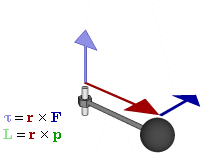In physics and mechanics, torque is the rotational equivalent of linear force. It is also referred to as
the moment, moment of force, rotational force or turning effect, depending on the field of study. The
concept originated with the studies by Archimedes of the usage of levers. Just as a linear force is a push
or a pull, a torque can be thought of as a twist to an object around a specific axis. Another definition of
torque is the product of the magnitude of the force and the perpendicular distance of the line of action of
a force from the axis of rotation. The symbol for torque is typically τ;, the lowercase Greek letter tau. When being referred to as moment
of force, it is commonly denoted by M.

Relationship between force F, torque τ, linear momentum p, and angular momentum L in a system which has rotation constrained to only one plane (forces and moments due to gravity and friction not considered).
In three dimensions, the torque is a pseudovector; for point particles, it is given by the cross product of
the position vector (distance vector) and the force vector. The magnitude of torque of a rigid body depends
on three quantities: the force applied, the lever arm vector connecting the point about which the torque
is being measured to the point of force application, and the angle between the force and lever arm vectors.
In symbols:


where,
τ; is the torque vector and τ; is the magnitude of the torque,
r is the position vector (a vector from the point about which the torque is being measured to the point where the force is applied),
F is the force vector,
X denotes the cross product, which produces a vector that is perpendicular to both r and F following the right-hand rule,
θ is the angle between the force vector and the lever arm vector.
The SI unit for torque is the Newton-metre (N⋅m). For more on the units of torque.
Defining terminology
James Thomson, the brother of Lord Kelvin, introduced the term torque into English scientific literature in 1884. However, torque is referred to using different vocabulary depending on geographical location and field of study. This article follows the definition used in US physics in its usage of the word torque. In the UK and in US mechanical engineering, torque is referred to as moment of force, usually shortened to moment. These terms are interchangeable in US physics[4] and UK physics terminology, unlike in US mechanical engineering, where the term torque is used for the closely related "resultant moment of a couple".
Torque and moment in the US mechanical engineering terminology
In US mechanical engineering, torque is defined mathematically as the rate of change of angular momentum of an object (in physics it is called "net torque"). The definition of torque states that one or both of the angular velocity or the moment of inertia of an object are changing. Moment is the general term used for the tendency of one or more applied forces to rotate an object about an axis, but not necessarily to change the angular momentum of the object (the concept which is called torque in physics). For example, a rotational force applied to a shaft causing acceleration, such as a drill bit accelerating from rest, results in a moment called a torque. By contrast, a lateral force on a beam produces a moment (called a bending moment), but since the angular momentum of the beam is not changing, this bending moment is not called a torque. Similarly with any force couple on an object that has no change to its angular momentum, such moment is also not called a torque.
In symbols:


where,
τ; is the torque vector and τ; is the magnitude of the torque,
r is the position vector (a vector from the point about which the torque is being measured to the point where the force is applied),
F is the force vector,
X denotes the cross product, which produces a vector that is perpendicular to both r and F following the right-hand rule,
θ is the angle between the force vector and the lever arm vector.
The SI unit for torque is the Newton-metre (N⋅m). For more on the units of torque.
Defining terminology
James Thomson, the brother of Lord Kelvin, introduced the term torque into English scientific literature in 1884. However, torque is referred to using different vocabulary depending on geographical location and field of study. This article follows the definition used in US physics in its usage of the word torque. In the UK and in US mechanical engineering, torque is referred to as moment of force, usually shortened to moment. These terms are interchangeable in US physics[4] and UK physics terminology, unlike in US mechanical engineering, where the term torque is used for the closely related "resultant moment of a couple".
Torque and moment in the US mechanical engineering terminology
In US mechanical engineering, torque is defined mathematically as the rate of change of angular momentum of an object (in physics it is called "net torque"). The definition of torque states that one or both of the angular velocity or the moment of inertia of an object are changing. Moment is the general term used for the tendency of one or more applied forces to rotate an object about an axis, but not necessarily to change the angular momentum of the object (the concept which is called torque in physics). For example, a rotational force applied to a shaft causing acceleration, such as a drill bit accelerating from rest, results in a moment called a torque. By contrast, a lateral force on a beam produces a moment (called a bending moment), but since the angular momentum of the beam is not changing, this bending moment is not called a torque. Similarly with any force couple on an object that has no change to its angular momentum, such moment is also not called a torque.